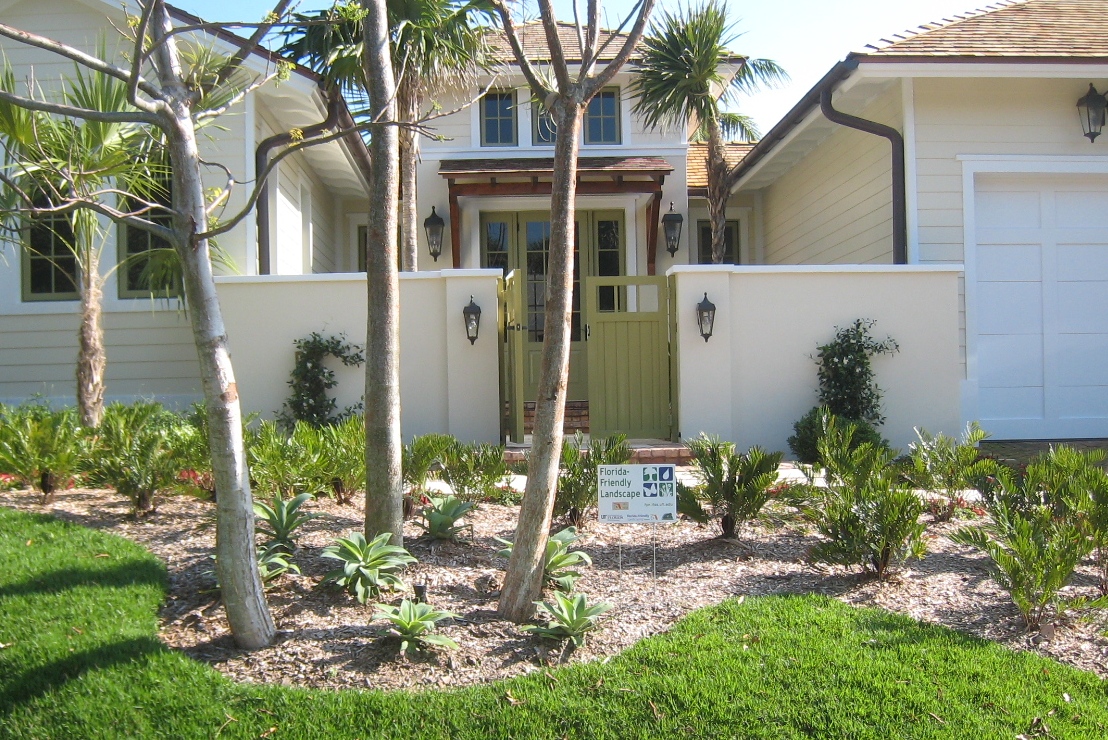
The Nine Principles
The Florida-Friendly Landscaping ™ program emphasizes nine major principles that allow residents to create beautiful yards and gardens while protecting our precious water, preserving natural resources, and saving on costs. We are a statewide public education program from the
University of Florida's Florida-Friendly Landscaping Program which currently partners with other Florida counties to promote sound landscape practices.
Objectives:
-
Water Conservation
-
Reduction of Storm-water Runoff
-
Creation of Wildlife Habitats
1. Right Plant, Right Place
Plants suited to your site will require minimal amounts of water, fertilizer and pesticides.
-
Use plants suited for site conditions: 
Low lying areas, select moisture loving plants
Shady areas, select plants with low light requirements
Sunny, dry locations, select drought tolerant plants.
-
Group plants according to their water needs.
-
Plant drought tolerant plants together and avoid scattering throughout lawn areas.
-
Determine how much grass you need for children, pets and recreation,. Use low maintenance ground covers, shrubs and mulch or other porous substances where possible.
-
Plant trees and shrubs to shade air conditioners and the east or west walls of your house to conserve energy. It will save you money!
-
Use deciduous trees or shrubs on the south side of your house to passively heat your home in the winter.
-
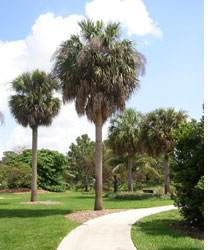
Remove invasive exotic plants from your yard! This will help to keep the dastardly Melaleuca, Australian Pine, Brazilian Pepper, Air Potato, Old World Climbing Fern, Carrotwood, Earleaf Acacia and Schefflera from seeding and spreading into other areas.
-
Reduce pruning labor and time by selecting plants with desired heights at maturity for particular locations. A plant that reaches a height of 8-10 feet will not be happy in place suited for a 2 foot plant. This will also cut down on yard waste.
-
Preserve and plant native plants whenever possible. They really like our hot humid summers!
2. Yard Pests
It is un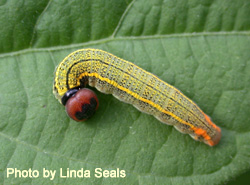 realistic to strive for a bug and disease-free landscape. Pesticides provide effective treatment of serious pest problems, but they should not be used routinely or indiscriminately. Unwise use of pesticides can result in pest resistance and can harm people, pets, beneficial organisms and the environment.
realistic to strive for a bug and disease-free landscape. Pesticides provide effective treatment of serious pest problems, but they should not be used routinely or indiscriminately. Unwise use of pesticides can result in pest resistance and can harm people, pets, beneficial organisms and the environment.
-
There are many beneficial organisms that prey on plant pests. When pesticides are broadcast sprayed over the entire yard, it kills everything! Limit this practice so that beneficial insects such as lady bugs, assassin bugs, green lacewings, big eyed bugs, earwigs, frogs, lizards and birds can thrive in your landscape.
-
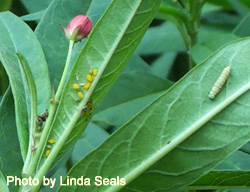
Use environmentally friendly controls first.
-
Prune and remove heavily infected plant parts or hand remove plant pests. Change cultural practices to provide less stress on the plants. Stressed plants are more susceptible to pests and diseases.
-
If you must spray, use insecticidal soaps, horticultural oils, isopropyl alcohol and Bacillus thuringiensis (Bt) Note: Bt is harmful to butterflies.
-
Reminder! Only 1% of insects are considered pests on plants!
3. Water Efficiently
Irrigate only when your lawn and landscape need water. Efficient watering is the key to a healthy Florida yard and reducing runoff.
-
Water your lawn and other plants only when they show signs of stress. Grass turns a bluish gray color, leaf blades fold in half and areas from footsteps don't stand back up.
-
Calibrate your irrigation system to apply ¾' to 1 inch of water per application.
-
Design or modify your sprinkler system to water lawn areas separate from plant beds.
-
Check for broken sprinklers and adjust crooked sprinklers to keep spray patterns distributed evenly.
-
Use micro irrigation in plant plants if you can.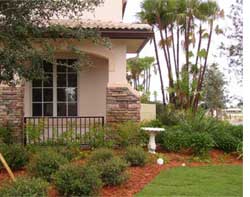
-
Connect an automatic rain shut off device to your irrigation system. It is REQUIRED by law on all newly installed systems.
-
Mow your lawn grass so it has a height of 3-4 inches after it is cut. The longer the shoot, the longer the root.
-
Put a rain gauge in your yard to track rainfall and avoid unnecessary waterings.
-
Design and maintain a yard that thrives on rainfall. Use irrigation only as a supplement to rain fall.
4. Fertilize Appropriately
Fertilizers can be hazardous to the environment and your yard. When over-applied, fertilizers aggravate pest problems and make plants grow excessively. Excess fertilizer can run off yards into groundwater creating water quality and ecological problems.
-
Use slow release fertilizers so they don't leach through our sandy soils quickly. 30% water insoluble nitrogen is desirable, it can be labeled as sulfur coated urea (SCU), ureaform (UF), polymer or resin coated urea.
-
Fertilize with light applications 5- 6 times per year.
-
Use ferrous sulfate (chelated iron) instead of nitrogen to make your lawn green in the summer.
5. Mulch
Mulching retains soil moisture, moderates soil temperature and helps prevent erosion and weeds. By using mulch, you'll use less water, have healthier plants and fewer weeds.
-
 Keep a 2-3 inch layer of mulch over the roots of trees and shrubs and in plant beds.
Keep a 2-3 inch layer of mulch over the roots of trees and shrubs and in plant beds.
-
Leave at least 2 inches of space between the mulch and plant's trunk or stem.
-
Replenish mulch once or twice a year.
-
Create self mulching areas under trees where leaves can stay where they fall.
-
Use by-product mulches whenever possible. Eucalyptus, Melaleuca and Australian pines make great mulches.
6. Recycle
In a Florida yard, grass clippings, leaves and yard trimmings are recycled rather than thrown away. They provide natural nutrients for the landscape.
-
Leave grass clippings on the lawn after mowing
-
Use fallen leaves and pine needles as mulch under trees and shrubs. It's FREE too!
-
Create and maintain a compost pile with yard waste and kitchen scraps. NO animal products.
7. Stormwater Runoff
What is stormwater runoff? Rainwater and excessive irrigation water that carries non point source  pollutants off of yards, roads and parking lots to our lakes rivers and estuaries. Non point source pollution includes pesticides, fertilizers oils, tire particles and trash that is carried from all over and cannot be pinpoint to any single cause.
pollutants off of yards, roads and parking lots to our lakes rivers and estuaries. Non point source pollution includes pesticides, fertilizers oils, tire particles and trash that is carried from all over and cannot be pinpoint to any single cause.
Rain and irrigation water carries soil, debris, fertilizer and pesticides from your yard into neighborhood storm drains that lead to bays, rivers and lakes. These substances can harm water quality, habitats and living organisms. Reducing runoff from your property minimizes these problems.
-
Where possible, direct downspouts and gutters to drain into plant beds or lawn areas.
-
Decrease soil erosion by planting groundcovers where lawn grass doesn't thrive.
-
Use mulch, brick, gravel, flagstones or other porous materials for driveways, walkways and patios
-
Sweep grass clippings, fertilizer and soil from driveways and streets back onto the lawn.
-
Avoid piling yard debris near storm drains, it can wash down them during heavy rains.
-
Remove trash from street gutters near your house. (even if it is NOT your trash)
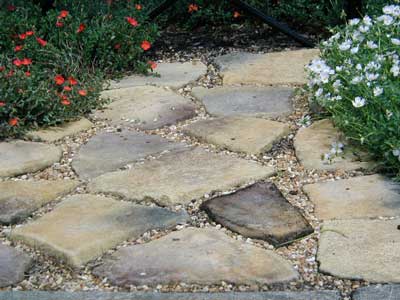
-
Create swales (low areas) to catch and filter stormwater.
-
Terrace sloping areas to slow down stormwater runoff.
-
Be a responsible pet owner - pick up after pets. This will help reduce bacterial and nutrient pollution entering our water bodies.
-
Clean up oil spills and leaks on the driveway by soaking up fluids with cat litter and sweeping up. Avoid washing with soap and water and flushing it down the stormdrain.
-
Pour fertilizer into spreaders over mulched areas not on the driveway where it might later be washed down the storm drain.
8. Protect the Waterfront
 Waterfront property owners have an important responsibility to keep fertilizers and pesticides out of the water body. Polluted water with toxic chemicals has a harmful effect on aquatic animals and can bring down the value of the waterfront property
Waterfront property owners have an important responsibility to keep fertilizers and pesticides out of the water body. Polluted water with toxic chemicals has a harmful effect on aquatic animals and can bring down the value of the waterfront property
-
Remove invasive exotic aquatic plants by cutting, pulling or raking. Remove excess dead plant material from water to keep it from adding excess nutrients.
-
Decrease wave action and increase wildlife habitats by placing clean native limestone in front of seawalls.
-
When feasible, plant native aquatic plants in front of your seawall.

-
Avoid pruning mangroves and other native vegetation without first checking on proper guidelines and permits.
-
If possible, plant a border of low maintenance plants between your lawn and the water's edge to absorb nutrients and provide habitat for animals.
-
Establish a 10-30 foot no fertilizer, no pesticide zone along the shoreline.
9. Wildlife Habitats
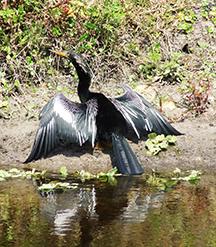 With more than 1,200 kinds of animals, Florida ranks third in the nation in wildlife diversity. Providing adequate food, water and shelter can increase the number and variety of species that visit your yard.
With more than 1,200 kinds of animals, Florida ranks third in the nation in wildlife diversity. Providing adequate food, water and shelter can increase the number and variety of species that visit your yard.
-
Plant trees, shrubs and vines that provide cover, nesting areas or food for birds, butterflies and other wildlife.
-
Make available a water source such as a bird bath (be sure and keep this clean) or small pond for wildlife.
-
Provide wildlife shelters such as bat houses, bird houses or in rural area areas- snags (dead trees).
-
Avoid routine spraying of pesticides- they kill many things, including the "good guys!"
Volunteers
In Palm Beach County, a knowledgeable group of Master Gardeners serve as Yard Advisors and visit your location and conduct an educational evaluation as to whether the property meets the minimum standards. Achievement of Florida-Friendly™ Yard Recognition is a great source of pride for residents, management, and owners. Successful recognition results in a sign posted on the property and entry into a statewide database. Recognition also earns points towards the Florida Green Building Coalition Green Home Certification.
Benefits of Florida-Friendly Landscaping
-
Aesthetic landscapes increase the value of your house and property
-
Reduces your water bill up to 40% after plants are established
-
Plant diversity increase interest and reduces the spread of insects and disease
-
Decreases the level of weekly maintenance in your yard
-
Reduces stormwater runoff to protect the fish and birds dependant on our lakes, rivers and estuaries
-
Decreases
non point source pollution function
going into our water bodies so they can be used for recreation
-
Creates habitat for birds and butterflies
-
Protects our natural resources for future generations